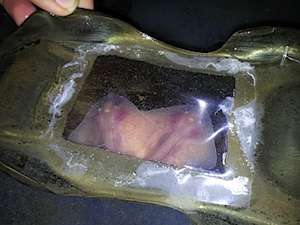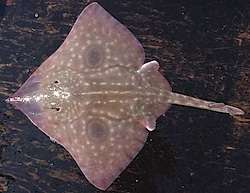Secrets of the 'mermaid's purse' explored in new study

Researchers at SF State have clarified part of the family tree of sea creatures called skates, shedding light on the evolution of a novel reproductive strategy in two skate species. Their study was published in the journal Molecular Phylogenetics and Evolution.
Researchers are just beginning to understand how and when cartilaginous fishes, a group of sea creatures that includes the skates, rays and sharks, evolved. The evolutionary relationships among skates and rays have been sorted out slowly since they were catalogued as one big group by taxonomists nearly 250 years ago. But there hasn't been a detailed molecular study of the family of hardnose skates called the Rajidae until now, said Karen Crow, an associate professor of biology and head of SF State's "Fish Lab."
Their analysis is one of the few studies to independently evaluate relationships of the egg-laying Rajidae species based on genetic sequences, for comparison with previous morphological studies, said Kelcie Chiquillo, the SF State undergraduate who is the first author of the study.
Chiquillo, Crow and their colleagues also took a closer look at the egg capsules, colloquially known as "mermaid's purses," produced by skates. Unlike most skate egg capsules, the capsules of the big skate (Beringraja binoculata) and the mottled skate (Beringraja pulchra) contain multiple embryos.

The researchers were able to confirm in their study that these two species are close relatives that share a common ancestor, suggesting that this unusual reproductive strategy arose only once during the evolutionary history of the Rajidae.
Until now, Crow explained, much of the work on sorting out the evolutionary relationships of the Rajidae "has been based on morphological characters of species in distinct geographic regions." Rather than study the skate species by geographic regions, a broad geographic approach would be necessary to trace their evolutionary relationships.
The new study re-classifies 53 species within the Rajidae, from the eastern and western Pacific and Atlantic Oceans and the Mediterranean Sea, based on sequence data from three mitochondrial genes. The resulting family tree led Crow and colleagues to propose that the family Rajidae should be divided up into three tribes, including a new tribe called Rostrorajini that is newly proposed by the authors.
To obtain the sequences, the researchers undertook the challenging task of searching for skate tissue samples from museums around the world. They also used data mining techniques to scour publicly available databases such as GenBank for relevant sequences.
"Some skates are difficult to sample," Crow said. "They often occur in deep water, and they're large animals that are not easy to capture." At the same time, tissue samples stored in museum collections are often preserved in compounds such as formalin that make it difficult to extract DNA.
Chiquillo, a marine biology major who is expected to graduate this spring, also designed an experiment to track survivorship of big skate egg capsules as part of a captive breeding program at Aquarium of the Bay in San Francisco. The egg capsules contain anywhere from two to eight embryos, but the most frequent number of embryos was two. Interestingly the two-embryo capsules also had the highest survival rates, "indicating that the most frequent strategy is also the most fit," Crow said.
"It might be easy to assume that a species with two to eight embryos in its egg capsule would have two to eight times greater fecundity than a species with one embryo per egg capsule, but this research shows this isn't necessarily the case," Crow said. Survivorship was variable and surprisingly low in all groups because some embryos died and some egg capsules became covered in fungus. This work provides valuable information necessary to understanding reproductive rates in big skates.
While many vertebrates lay eggs, it's very rare to see multiple embryos in one egg capsule as in Beringraja, Crow said. "There are many more mysteries of the mermaid's purse, and it would be interesting to determine the paternity of multiple embryos, and to learn more about why this selection has favored such a unique strategy."
More information: "The secret of the mermaid's purse: Phylogenetic affinities within the Rajidae and the evolution of a novel reproductive strategy in skates," by Chiquillo, Crow, David Ebert of the Pacific Shark Research Center and Christina Slager of Aquarium of the Bay, was published online on Jan. 31 in the journal Molecular Phylogenetics and Evolution. www.sciencedirect.com/science/ … ii/S1055790314000256
Journal information: Molecular Phylogenetics and Evolution
Provided by San Francisco State University



















